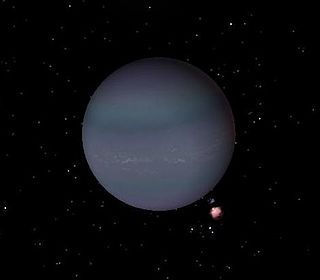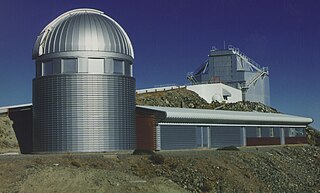Related Research Articles
HD 82943 is a yellow dwarf star approximately 89 light-years away in the constellation of Hydra. Two extrasolar planets have been confirmed to be orbiting it, and it is thought that the system had more giant planets that were "swallowed" by the parent star. HD 82943 is estimated at 1.15 times the mass of the Sun.
HD 169830 is a star in the southern constellation of Sagittarius. It has a yellow-white hue and is dimly visible to the naked eye with an apparent visual magnitude of +5.90. The star is located at a distance of 120 light years from the Sun based on parallax. It is drifting closer with a radial velocity of −17.3 km/s, and is predicted to come as close as 20.7 ly (6.4 pc) in 2.08 million years. HD 169830 is known to be orbited by two large Jupiter-like exoplanets.
HD 121504 is an 8th magnitude star in the constellation of Centaurus. It is a yellow dwarf and remarkably similar to the Sun, only slightly brighter like α Centauri A. However, it is located at a distance of about 135 light years and thus is not visible to the unaided eye; binoculars or small telescope is required to see this star.

HD 28185 b is an extrasolar planet 128 light-years away from Earth in the constellation of Eridanus. The planet was discovered orbiting the Sun-like star HD 28185 in April 2001 as a part of the CORALIE survey for southern extrasolar planets, and its existence was independently confirmed by the Magellan Planet Search Survey in 2008. HD 28185 b orbits its sun in a circular orbit that is at the inner edge of its star's habitable zone.
HD 82943 c is an extrasolar planet approximately 89 light-years away in the constellation of Hydra. The planet was announced in 2001 to be orbiting the yellow dwarf star HD 82943. The planet is the innermost planet of two.
ρ Indi, Latinised as Rho Indi, is a yellow-hued star in the constellation Indus. With an apparent visual magnitude of +6.05 it is, barely, a naked eye star, not visible in the northern hemisphere outside the tropics. Based upon an annual parallax shift of 37.46 mas, it is located 87 light-years from the Sun. The star is moving closer to the Sun with a radial velocity of −2 km/s.
HD 4113 A b is a jovian planet located approximately 137 light-years away in the constellation of Sculptor, orbiting a star in the binary system HD 4113 A. This planet has a very eccentric orbit with a 527-day period at 1.28 AU from the parent star. At periastron, the distance is 0.124 AU and at apastron, the distance is 2.44 AU.
HD 6434 b is an extrasolar planet orbiting the star HD 6434. It has a minimum mass about half that of Jupiter. It orbits the star very close, over 2.5 times as close as Mercury orbits the Sun. For this reason it completes one orbit in only 22 days. Unlike true "hot Jupiters" like 51 Pegasi b, HD 6434 b does not have a circular orbit, but rather an eccentric one.
HD 216770 b is an extrasolar planet orbiting the star HD 216770. It has a mass about two thirds that of Jupiter, largest planet in the Solar System. But unlike the gas giants in the Solar System, it orbits in a very eccentric orbit around the star. The mean distance from the star is slightly larger than Mercury's, and it completes one orbit around the star in every 118 days.

HD 108147 b, also named Tumearandu, is a gas giant exoplanet with a minimum mass about half that of Jupiter. It orbits the star in a very tight "torch orbit". The distance between the planet and the star is only a tenth of the distance between Earth and the Sun (0.1AU). A number of such worlds are known to exist, but the eccentricity of this planet is unusually high. Planets orbiting very close to their parent stars usually have round orbits because of the tidal forces between the bodies.
HD 111232 b is an extrasolar planet that orbits at almost 2 AU with a minimum mass of 6.8 times that of Jupiter. This planet was discovered in the La Silla Observatory by Michel Mayor using the CORALIE spectrograph on 30 June 2003, along with six other planets, including HD 41004 Ab, HD 65216 b, HD 169830 c, HD 216770 b, HD 10647 b, and HD 142415 b.
HD 114386 b is an exoplanet orbiting the star HD 114386. The planet orbits the star in a rather eccentric orbit. Mean distance from the star is 1.62 AU, somewhat more than distance between Mars and the Sun. At periastron, the planet comes almost as close as Earth orbits the Sun, and at apoastron, the distance is twice as much.
HD 169830 b is an extrasolar planet three times the mass of Jupiter. Due to its high mass, it is most likely a gas giant planet, akin to Jupiter and Saturn in the Solar System. This planet at 0.8 AU is slightly farther out than Venus is in the Solar System, orbiting around its star every 262 days.
HD 130322 b is an exoplanet with a minimum mass slightly more than that of Jupiter. It orbits the star in a very close orbit distance being only a quarter that of Mercury from the Sun. It is thus a so-called "hot Jupiter". The planet orbits the star every 10 days 17 hours in a very circular orbit.
HD 65216 b is an extrasolar planet located approximately 115 light-years away in the constellation of Carina, orbiting the star HD 65216. This planet was discovered by the Geneva Extrasolar Planet Search Team in 2003. Like most planet candidates so far, it was detected with the radial velocity method.
HD 83443 b is an extrasolar planet approximately 134 light-years away in the constellation of Vela. It was discovered in 2000 by the Geneva Extrasolar Planet Search Team led by Michel Mayor. It has a minimum mass comparable to Saturn, and its orbit is one of the shortest known, 1/25th that of Earth's. It takes only three days to complete one revolution around the star.
HD 213240 b is an exoplanet located 134 light-years from the Solar System in the constellation of Grus. It is a gas giant orbiting the G-type star HD 213240.
HD 142415 b is an exoplanet with the semi-amplitude of 51.3 ± 2.3 m/s. This indicates the minimum mass of 1.69 Jupiter mass, an orbital period of 386.3 days, and the semi-major axis of 1.07 astronomical units based from its stellar mass. The wild, oval pathed wobble of the star used by Doppler spectrometer indicates that the orbit of the planet is highly eccentric at around 50%.
HD 147513 b is an exoplanet approximately 42 light-years away in the constellation of Scorpius. It is at least 21% more massive than Jupiter. But unlike Jupiter, it orbits the star much closer, mean distance being only a third more than Earth's distance from the Sun. Its orbit is also eccentric; at periastron, it is closer to its star than Earth is from the Sun, whereas at apastron, it is further from its star than Mars to the Sun, finding itself on the outer edge of the habitable zone.

Leonhard Euler Telescope, or the Swiss EULER Telescope, is a national, fully automatic 1.2-metre (47 in) reflecting telescope, built and operated by the Geneva Observatory. It is located at an altitude of 2,375 m (7,792 ft) at ESO's La Silla Observatory site in the Chilean Norte Chico region, about 460 kilometers north of Santiago de Chile. The telescope, which saw its first light on 12 April 1998, is named after Swiss mathematician Leonhard Paul Euler.
References
- ↑ Mayor, M.; et al. (2004). "The CORALIE survey for southern extra-solar planets XII. Orbital solutions for 16 extra-solar planets discovered with CORALIE". Astronomy and Astrophysics. 415 (1): 391–402. arXiv: astro-ph/0310316 . Bibcode:2004A&A...415..391M. doi:10.1051/0004-6361:20034250. S2CID 5233877.